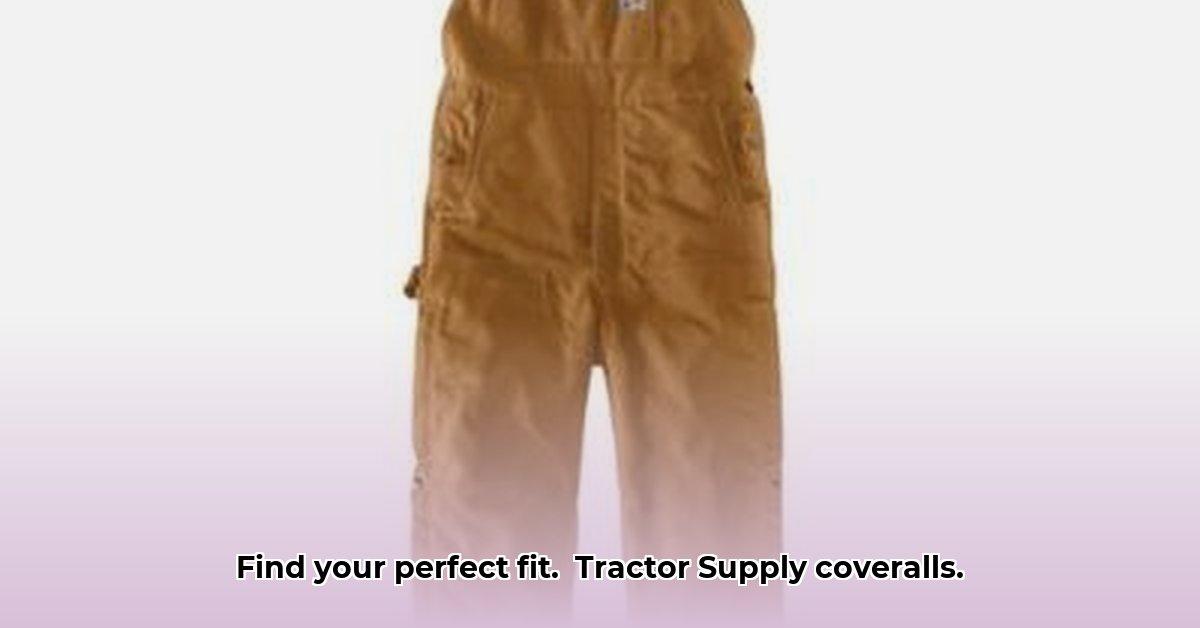
Coverall Tractor Supply: Your Ultimate Buying Guide
Choosing the right work coveralls can be surprisingly complex. This guide cuts through the jargon, helping you find the perfect Tractor Supply coveralls for your needs, focusing on durability and its connection to sustainable farming practices. We'll explore fabric types, essential features, and proper care to maximize the lifespan of your coveralls, reducing waste and promoting responsible resource management.
Matching Coveralls to Your Work
Before selecting coveralls, consider your work environment. Farmers need durability and weather resistance; construction workers require reinforced knees and elbows; gardeners prioritize breathability. The type of work dictates the essential features. What are your primary work tasks? How will this influence your coverall choice?
The Fabric Factor: Comfort Meets Durability
The fabric determines both durability and comfort. Let's compare popular choices:
| Material | Pros | Cons |
|---|---|---|
| Heavy-Duty Canvas | Extremely durable, resists tears and abrasions, excellent protection. | Less breathable in warm weather. |
| Ripstop Nylon | Lightweight, durable, tear-resistant, and breathable. | Might not offer the same abrasion resistance as canvas. |
| Cotton Blend | Comfortable, breathable, often more affordable. | Less durable than canvas or nylon, less resistant to tears and abrasions. |
Climate heavily influences material choice. Heavy canvas excels in cold, wet conditions, while lighter nylon or cotton blends are suitable for warmer weather. Which material best suits your climate and work intensity?
Key Features: Enhancing Safety and Productivity
Beyond fabric, consider essential features:
- Pockets: For tool storage.
- Reinforcements: At knees and elbows for added durability.
- Reflectivity: For enhanced visibility in low-light conditions.
- Knee Pads: For added comfort during prolonged kneeling.
- Flame-resistant materials: For hazardous environments.
These features can significantly impact safety and comfort. Which features are essential for your work?
Finding Your Perfect Fit
Proper sizing is crucial for comfort and safety. Consult Tractor Supply's size chart and take your measurements before purchasing. If unsure, size up for greater comfort and movement. Do you plan to layer clothing underneath? This might influence your size choice.
Budget-Friendly Choices: Long-Term Value
While cheaper options are tempting, higher-quality coveralls offer longer lifespans, making them more cost-effective in the long run. A mid-range option often provides the best balance between durability and affordability. How does long-term value factor into your purchasing decision? Is a slightly higher initial cost offset by increased lifespan and reduced waste?
Your Step-by-Step Guide to Coverall Selection
- Define Your Work: Identify your primary tasks.
- Material Selection: Choose canvas, nylon, or cotton blend based on climate and work intensity.
- Feature Focus: Select essential features based on your work environment.
- Accurate Sizing: Measure carefully and consult the size chart.
- Budget Wisely: Balance quality, longevity, and cost.
- Read Reviews: Learn from other customer experiences.
- Purchase: Order with confidence from Tractor Supply.
Sustainable Farming Practices: The Connection to Durable Coveralls
Investing in durable coveralls directly relates to sustainable farming practices. High-quality coveralls, like those from Tractor Supply, reduce textile waste compared to frequently replacing cheaper alternatives. This aligns with environmentally conscious farming practices. Extending the life of your coveralls by even a single year significantly reduces your environmental impact.
"Extending the lifespan of workwear is a simple yet effective way to reduce textile waste and contribute to sustainable practices within agriculture," says Dr. Emily Carter, Environmental Scientist, University of California, Berkeley.
This guide empowers you to make informed choices, ensuring your workwear contributes to both your personal productivity and the long-term sustainability of your farming operation.